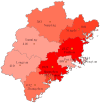Shift in HIV/AIDS Epidemic in Southeastern China: A Longitudinal Study from 1987 to 2015
- PMID: 27509511
- PMCID: PMC4997480
- DOI: 10.3390/ijerph13080794
Shift in HIV/AIDS Epidemic in Southeastern China: A Longitudinal Study from 1987 to 2015
Abstract
Objective: The aim of this study was to investigate the shift in the epidemiological features of HIV/AIDS during the last three decades in Fujian Province, southeastern China, so as to provide evidence for the development of novel HIV/AIDS control strategies.
Methods: Data pertaining to the conventional surveillance, sentinel surveillance and epidemiological survey in Fujian Province during the period from 1987 to 2015 were collected. The epidemiological trends were described, and the subtypes of HIV strain were genotyped. In addition, the response to antiretroviral therapy was evaluated, and HIV genotypic resistance was assayed.
Results: There was an increasing trend observed in the reported cases of HIV/AIDS in Fujian Province. From 1987 to the end of 2015, a total of 8651 HIV/AIDS cases were reported across the province, with totally 1557 deaths found. Among the total cases, the ratio of male/female cases was 3.7:1, which appeared to be an increasing trend; 77.1% cases were detected in young and middle-aged populations aged 19 to 50 years, however, the new HIV infections recently tended to occur in young people aged 15 to 18 years and in populations aged 50 years and older. Among all infected individuals, 49.3% were married, however, the percentage of unmarried cases increased from 6.67% before 1994 to 40.1% in 2015; 64.8% had junior high school education or lower, however, the proportion of HIV/AIDS cases with junior college education or above gradually increased from 6.5% in 2009 to 21.4% in 2015. The reported HIV/AIDS cases were predominantly found in coastal regions; however, a rapidly increasing trend was seen in the number of HIV/AIDS cases in inland regions, and the geographical variation of the cases gradually reduced. There were multiple routes of HIV transmission found in Fujian Province, and 94.2% infections were sexually transmitted, with a large increase in the percentage of male homosexual transmission. A variety of HIV-1 subtypes were genotyped in the province during the study period, and CRF01-AE and CRF07-BC intersubtype recombinant forms were predominant; however, a declining trend in the proportion of HIV-1 CRF01-AE recombinant virus and a significant rise in the proportion of HIV-1 CRF07-BC recombinant virus were observed. Over 90% HIV inhibition was found in all cases receiving antiretroviral therapy during the period from 2011 to 2015, indicating a low prevalence of HIV drug resistance.
Conclusions: An increasing trend is still observed in the HIV/AIDS epidemics in Fujian Province, southeastern China. However, the epidemiological pattern of HIV/AIDS has recently changed in the province, and effective control interventions targeting the shift in the epidemiological features of HIV/AIDS should therefore be implemented to control the spread of the epidemic.
Keywords: AIDS; Fujian Province; HIV; antiretroviral therapy; drug resistance; genotyping; molecular epidemiology; spatial-temporal characteristics.
Figures













Similar articles
-
Surging HIV-1 CRF07_BC epidemic among recently infected men who have sex with men in Fujian, China.J Med Virol. 2018 Jul;90(7):1210-1221. doi: 10.1002/jmv.25072. Epub 2018 Mar 31. J Med Virol. 2018. PMID: 29574774
-
[Molecular epidemiological characteristics of newly diagnosed HIV-1 cases in Fujian Province in 2020].Zhongguo Xue Xi Chong Bing Fang Zhi Za Zhi. 2023 Dec 1;35(6):583-589. doi: 10.16250/j.32.1374.2023003. Zhongguo Xue Xi Chong Bing Fang Zhi Za Zhi. 2023. PMID: 38413019 Chinese.
-
Dominance of HIV-1 subtype CRF01_AE in sexually acquired cases leads to a new epidemic in Yunnan province of China.PLoS Med. 2006 Nov;3(11):e443. doi: 10.1371/journal.pmed.0030443. PLoS Med. 2006. PMID: 17105339 Free PMC article.
-
Rising HIV infection rates in Ho Chi Minh City herald emerging AIDS epidemic in Vietnam.AIDS. 1997 Sep;11 Suppl 1:S5-13. AIDS. 1997. PMID: 9376101 Review.
-
[The epidemiological aspects of HIV/AIDS in Brazil].Rev Soc Bras Med Trop. 1993 Apr-Jun;26(2):101-11. doi: 10.1590/s0037-86821993000200006. Rev Soc Bras Med Trop. 1993. PMID: 8128069 Review. Portuguese.
Cited by
-
HIV infection in Xi'an, China: epidemic characterization, risk factors to false positives and potential utility of the sample-to-cutoff index to identify true positives using Architect HIV Ag/Ab combo.Antimicrob Resist Infect Control. 2019 Jan 11;8:9. doi: 10.1186/s13756-019-0463-0. eCollection 2019. Antimicrob Resist Infect Control. 2019. PMID: 30651975 Free PMC article.
-
Prevalence of HIV Indeterminate Western Blot Tests and Follow-up of HIV Antibody Sero-Conversion in Southeastern China.Virol Sin. 2019 Aug;34(4):358-366. doi: 10.1007/s12250-019-00130-3. Epub 2019 Jun 12. Virol Sin. 2019. PMID: 31190120 Free PMC article.
-
Epidemiology and Clinical Outcomes of HIV Infection in South-Central China: A Retrospective Study From 2003 to 2018.Front Public Health. 2022 Jun 9;10:902537. doi: 10.3389/fpubh.2022.902537. eCollection 2022. Front Public Health. 2022. PMID: 35757651 Free PMC article.
-
Shift in HIV/AIDS Epidemic and Factors Associated with False Positives for HIV Testing: A Retrospective Study from 2013 to 2018 in Xi'an, China.Curr HIV Res. 2020;18(3):219-226. doi: 10.2174/1570162X18666200415123607. Curr HIV Res. 2020. PMID: 32294041 Free PMC article.
-
Sample-to-cutoff ratios using Architect HIV Ag/Ab Combo: The influence with the results of supplemental tests and optimal cutoff value to predict HIV infection.J Clin Lab Anal. 2019 Jun;33(5):e22866. doi: 10.1002/jcla.22866. Epub 2019 Feb 25. J Clin Lab Anal. 2019. PMID: 30803030 Free PMC article.
References
-
- Hogg R., Cahn P., Katabira E.T., Lange J., Samuel N.M., O’Shaughnessy M., Vella S., Wainberg M.A., Montaner J. Time to act: Global apathy towards HIV/AIDS is a crime against humanity. Lancet. 2002;360:1710–1711. - PubMed
-
- Sheng L., Cao W.K. HIV/AIDS epidemiology and prevention in China. Chin. Med. J. (Engl.) 2008;121:1230–1236. - PubMed
-
- National Center for AIDS/STD Control and Prevention Update on the AIDS/STD epidemic in China and main response in control and prevention in December 2015. Chin. J. AIDS/STD. 2016;22:69. (In Chinese)
MeSH terms
LinkOut - more resources
Full Text Sources
Other Literature Sources
Medical

